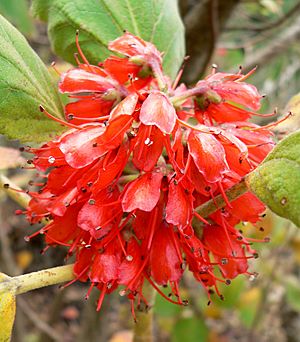Natal bottlebrush facts for kids
Quick facts for kids Natal bottlebrush |
|
|---|---|
 |
|
| Scientific classification | |
| Genus: |
Greyia
|
| Species: |
radlkoferi
|
Greyia radlkoferi, also known as the woolly bottlebrush or Natal bottlebrush, is a type of shrub or small tree. It grows naturally in South Africa. This plant can reach up to 5 metres (about 16 feet) tall.
The woolly bottlebrush has smooth, yellowish bark when it is young. As the tree gets older, its bark turns grey and develops deep grooves. Its leaves are shaped like an oval or a heart. A special feature of this plant is the woolly texture on the underside of its leaves. This helps tell it apart from a similar plant, Greyia sutherlandii.
The flowers of the woolly bottlebrush are a bright scarlet red. They grow in thick, upright bunches. These beautiful flowers appear from July to October in its native home.
Contents
What's in a Name?
The scientific name Greyia radlkoferi honors a person named Ludwig Adolph Timotheus Radlkofer. He was a botanist, which is a scientist who studies plants.
Where It Grows
The woolly bottlebrush is native to certain parts of South Africa. It prefers rocky areas and slopes, often found growing in grasslands or open woodlands. This plant is well-adapted to its environment.
How It Grows and Looks
This plant can grow as a large shrub or a small tree. Its strong branches help it stand tall. The unique bark changes color and texture as the plant matures, showing its age.
Leaves and Flowers
The leaves are not only heart-shaped but also have a soft, woolly feel on their underside. This woolly layer might help protect the leaves from harsh weather or insects.
The bright red flowers are a big attraction. They are shaped like a bottlebrush, which is how the plant gets its common name. These flowers are very popular with birds and insects. They provide nectar, which is a sweet liquid that gives energy to pollinators.
Life Cycle and Reproduction
The woolly bottlebrush produces its striking red flowers during the late winter and spring months in South Africa. These flowers are designed to attract pollinators like sunbirds, which have long beaks perfect for reaching the nectar deep inside the blooms.
After the flowers are pollinated, they develop into small fruits. These fruits contain tiny seeds. When the seeds are mature, they are dispersed, often by wind or animals. If the conditions are right, these seeds can sprout and grow into new woolly bottlebrush plants, continuing the life cycle.
Uses and Importance
The woolly bottlebrush is valued for its beautiful flowers and unique appearance. It is sometimes planted in gardens in South Africa as an ornamental plant. This means it is grown for its beauty.
It also plays a role in its natural ecosystem. The flowers provide food for pollinators, and the plant itself offers habitat for various small creatures. It is a part of the rich plant diversity of South Africa.

